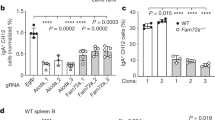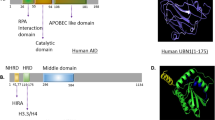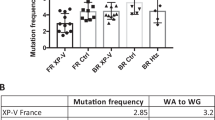Abstract
Activation-induced cytidine deaminase (AID) has been shown to trigger three mechanisms for diversifying immunoglobulin genes—somatic hypermutation, isotype switch recombination and gene conversion—most probably by initiating cytidine deamination at the immunoglobulin locus. Although this deamination process has been shown to be potentially mutagenic by itself, most of the mutations generated in the physiological hypermutation process seem to be created through the AID-mediated assembly of a mutasome complex involving specific repair activities and error-prone DNA polymerases.
This is a preview of subscription content, access via your institution
Access options
Subscribe to this journal
Receive 12 print issues and online access
$209.00 per year
only $17.42 per issue
Buy this article
- Purchase on Springer Link
- Instant access to full article PDF
Prices may be subject to local taxes which are calculated during checkout


Similar content being viewed by others
References
Hesslein, D.G. & Schatz, D.G. Factors and forces controlling V(D)J recombination. Adv. Immunol. 78, 169–232 (2001).
Berek, C. & Milstein, C. The dynamic nature of the antibody repertoire. Immunol. Rev. 105, 5–26 (1988).
Stavnezer, J. Antibody class switching. Adv. Immunol. 61, 79–146 (1996).
Weill, J.-C. & Reynaud, C.-A. Rearrangement/hypermutation/gene conversion: when, where and why? Immunol. Today 17, 92–97 (1996).
Muramatsu, M. et al. Class switch recombination and hypermutation require activation-induced cytidine deaminase (AID), a potential RNA editing enzyme. Cell 102, 553–563 (2000).
Revy, P. et al. Activation-induced cytidine deaminase (AID) deficiency causes the autosomal recessive form of the Hyper-IgM syndrome (HIGM2). Cell 102, 565–575 (2000).
Harris, R.S., Sale, J.E., Petersen-Mahrt, S.K. & Neuberger, M.S. AID is essential for immunoglobulin V gene conversion in a cultured B cell line. Curr. Biol. 12, 435–438 (2002).
Arakawa, H., Hauschild, J. & Buerstedde, J.M. Requirement of the activation-induced deaminase (AID) gene for immunoglobulin gene conversion. Science 295, 1301–1306 (2002).
Yoshikawa, K. et al. AID enzyme-induced hypermutation in an actively transcribed gene in fibroblasts. Science 296, 2033–2036 (2002).
Okazaki, I.M., Kinoshita, K., Muramatsu, M., Yoshikawa, K. & Honjo, T. The AID enzyme induces class switch recombination in fibroblasts. Nature 416, 340–345 (2002).
Gearhart, P. & Wood, R.D. Emerging links between hypermutation of antibody genes and DNA polymerases. Nat. Rev. Immunol. 1, 187–192 (2001).
Martin, A. & Scharff, M.D. AID and mismatch repair in antibody diversification. Nat. Rev. Immunol. 2, 605–614 (2002).
Papavasiliou, F.N. & Schatz, D.G. Somatic hypermutation of immunoglobulin genes: merging mechanisms for genetic diversity. Cell 109, S35–44 (2002).
Honjo, T., Kinoshita, K. & Muramatsu, M. Molecular mechanism of class switch recombination: linkage with somatic hypermutation. Annu. Rev. Immunol. 20, 165–196 (2002).
Manis, J.P., Tian, M. & Alt, F.W. Mechanism and control of class-switch recombination. Trends Immunol. 23, 31–39 (2002).
Weill, J.-C. et al. Ig gene hypermutation: a mechanism is due. Adv. Immunol. 80, 183–202 (2002).
Muramatsu, M. et al. Specific expression of activation-induced cytidine deaminase (AID), a novel member of the RNA-editing deaminase family in germinal center B cells. J. Biol. Chem. 274, 18470–18476 (1999).
Anant, S. & Davidson, N.O. Molecular mechanisms of apolipoprotein B mRNA editing. Curr. Opin. Lipidol. 12, 159–165 (2001).
Wilson, M. et al. What limits affinity maturation of antibodies in Xenopus—the rate of somatic mutation or the ability to select mutants? EMBO J. 11, 4337–4719 (1992).
Bachl, J. & Wabl, M. An immunoglobulin mutator that targets G.C base pairs. Proc. Natl. Acad. Sci. USA 93, 851–855 (1996).
Rada, C., Ehrenstein, M.R., Neuberger, M.S. & Milstein, C. Hot-spot focusing of somatic hypermutation in MSH2-deficient mice suggests two stages of mutational targeting. Immunity 9, 135–141 (1998).
Frey, S. et al. Mismatch repair deficiency interferes with the accumulation of mutations in chronically stimulated B cells and not with the hypermutation process. Immunity 9, 127–134 (1998).
Phung, Q.H. et al. Increased hypermutation at G and C nucleotides in immunoglobulin variable genes from mice deficient in the MSH2 mismatch repair protein. J. Exp. Med. 187, 1745–1751 (1998).
Jacobs, H. et al. Hypermutation of immunoglobulin genes in memory B cells of DNA repair-deficient mice. J. Exp. Med. 187, 1735–1743 (1998).
Denepoux, S. et al. Induction of somatic mutation in a human B cell line in vitro. Immunity 6, 35–46 (1997).
Sale, J.E. & Neuberger, M.S. TdT-accessible breaks are scattered over the immunoglobulin V domain in a constitutively hypermutating B cell line. Immunity 9, 859–869 (1998).
Zan, H. et al. Induction of Ig somatic hypermutation and class switching in a human monoclonal IgM+IgD+ B cell line in vitro: definition of the requirements and modalities of hypermutation. J. Immunol. 162, 3437–3447 (1999).
Martin, A. et al. Activation-induced cytidine deaminase turns on somatic hypermutation in hybridomas. Nature 415, 802–806 (2002).
Di Noia, J. & Neuberger, M.S. Altering the pathway of immunoglobulin hypermutation by inhibiting uracil-DNA glycosylase. Nature 419, 43–48 (2002).
Rada, C. et al. Immunoglobulin isotype switching is inhibited and somatic hypermutation perturbed in UNG-deficient mice. Curr. Biol. 12, 1748–1755 (2002).
Petersen-Mahrt, S.K., Harris, R.S. & Neuberger, M.S. AID mutates E. coli suggesting a DNA deamination mechanism for antibody diversification. Nature 418, 99–103 (2002).
Harris, R.S., Petersen-Mahrt, S.K. & Neuberger, M.S. RNA editing enzyme APOBEC1 and some of its homologs can act as DNA mutators. Mol. Cell 10, 1247–1253 (2002).
Doi, T., Kinoshita, K., Ikegawa, M., Muramatsu, M. & Honjo, T. De novo protein synthesis is required for the activation-induced cytidine deaminase function in class-switch recombination. Proc. Natl. Acad. Sci. USA. 100, 2634–2638 (2003).
Krokan, H.E., Drablos, F. & Slupphaug, G. Uracil in DNA—occurrence, consequences and repair. Oncogene 21, 8935–8948 (2002).
Tissier, A., McDonald, J.P., Frank, E.G. & Woodgate, R. Pol ι, a remarkably error-prone human DNA polymerase. Genes Dev. 14, 1642–1650 (2000).
Matsuda, T. et al. Low fidelity DNA synthesis by human DNA polymerase-η. Nature 404, 1011–1013 (2000).
Kunkel, T.A., Pavlov, Y.I. & Bebenek, K. Functions of human DNA polymerases η, κ and ι suggested by their properties, including fidelity with undamaged DNA templates. DNA Repair 2, 135–149 (2003).
Johnson, R.E., Washington, M.T., Haracska, L., Prakash, S. & Prakash, L. Eukaryotic polymerases ι and ζ act sequentially to bypass DNA lesions. Nature 406, 1015–1019 (2000).
Bemark, M., Khamlichi, A.A., Davies, S.L. & Neuberger, M.S. Disruption of mouse polymerase ζ (Rev3) leads to embryonic lethality and impairs blastocyst development in vitro. Curr. Biol. 10, 1213–1216 (2000).
Wittschieben, J. et al. Disruption of the developmentally regulated Rev3l gene causes embryonic lethality. Curr. Biol. 10, 1217–1220 (2000).
Esposito, G. et al. Disruption of the Rev3l-encoded catalytic subunit of polymerase ζ in mice results in early embryonic lethality. Curr. Biol. 10, 1221–1224 (2000).
Morrison, A. et al. REV3, a Saccharomyces cerevisiae gene whose function is required for induced mutagenesis, is predicted to encode a nonessential DNA polymerase. J. Bacteriol. 171, 5659–5667 (1989).
Masutani, C. et al. The XPV (xeroderma pigmentosum variant) gene encodes human DNA polymerase η. Nature 399, 700–704 (1999).
Johnson, R.E., Kondratick, C.M., Prakash, S. & Prakash, L. hRAD30 mutations in the variant form of xeroderma pigmentosum. Science 285, 263–265 (1999).
Zeng, X. et al. DNA polymerase η is an A-T mutator in somatic hypermutation of immunoglobulin variable genes. Nat. Immunol. 2, 537–541 (2001).
Yavuz, S., Yavuz, A.S., Kraemer, K.H. & Lipsky, P.E. The role of polymerase η in somatic hypermutation determined by analysis of mutations in a patient with xeroderma pigmentosum variant. J. Immunol. 169, 3825–3830 (2002).
Faili, A. et al. AID-dependent somatic hypermutation occurs as a DNA single strand event in the BL2 cell line. Nat. Immunol. 3, 815–821 (2002).
Greagg, M.A. et al. A read-ahead function in archaeal DNA polymerases detects promutagenic template-strand uracil. Proc. Natl. Acad. Sci. USA 96, 9045–9050 (1999).
Faili, A. et al. Induction of somatic hypermutation in immunoglobulin genes is dependent on DNA polymerase ι. Nature 419, 944–947 (2002).
Kannouche, P. et al. Localization of DNA polymerases η and ι to the replication machinery is tightly co-ordinated in human cells. EMBO J. 21, 6246–6256 (2002).
Rogozin, I.B. & Kolchanov, N.A. Somatic hypermutagenesis in immunoglobulin genes. II. Influence of neighbouring base sequences on mutagenesis. Biochim. Biophys. Acta 1171, 11–18 (1992).
Rogozin, I.B., Pavlov, Y.I., Bebenek, K., Matsuda, T. & Kunkel, T.A. Somatic mutation hotspots correlate with DNA polymerase η error spectrum. Nat. Immunol. 2, 530–536 (2001).
Pavlov, Y.I. et al. Correlation of somatic hypermutation specificity and A-T base pair substitution errors by DNA polymerase η during copying of a mouse immunoglobulin κ light chain transgene. Proc. Natl. Acad. Sci. USA 99, 9954–9959 (2002).
Zan, H. et al. The translesion DNA polymerase ζ plays a major role in Ig and Bcl-6 somatic hypermutation. Immunity 14, 643–653 (2001).
Diaz, M., Verkoczy, L.K., Flajnik, M.F. & Klinman, N.R. Decreased frequency of somatic hypermutation and impaired affinity maturation but intact germinal center formation in mice expressing antisense RNA to DNA polymerase ζ. J. Immunol. 167, 327–335 (2001).
Reynaud, C.A. et al. Mismatch repair and immunoglobulin gene hypermutation: did we learn something? Immunol. Today 20, 522–527 (1999).
Alabyev, B. & Manser, T. Bcl-2 rescues the germinal center response but does not alter the V gene somatic hypermutation spectrum in MSH2-deficient mice. J. Immunol. 169, 3819–3824 (2002).
Wiesendanger, M., Kneitz, B., Edelmann, W. & Scharff, M.D. Somatic hypermutation in MutS homologue (MSH)3-, MSH6-, and MSH3/MSH6-deficient mice reveals a role for the MSH2-MSH6 heterodimer in modulating the base substitution pattern. J. Exp. Med. 191, 579–584 (2000).
Phung, Q.H., Winter, D.B., Alrefai, R. & Gearhart, P.J. Hypermutation in Ig V genes from mice deficient in the MLH1 mismatch repair protein. J. Immunol. 162, 3121–3124 (1999).
Winter, D.B. et al. Altered spectra of hypermutation in antibodies from mice deficient for the DNA mismatch repair protein PMS2. Proc. Natl. Acad. Sci. USA 95, 6953–6958 (1998).
Ehrenstein, M.R., Rada, C., Jones, A.M., Milstein, C. & Neuberger, M.S. Switch junction sequences in PMS2-deficient mice reveal a microhomology-mediated mechanism of Ig class switch recombination. Proc. Natl. Acad. Sci. USA 98, 14553–14558 (2002).
Wang, H., Lawrence, C.W., Li, G.M. & Hays, J.B. Specific binding of human MSH2-MSH6 mismatch-repair protein heterodimers to DNA incorporating thymine- or uracil-containing UV light photoproducts opposite mismatched bases. J. Biol. Chem. 274, 16894–16900 (1999).
Edelmann, W. et al. Mutation in the mismatch repair gene Msh6 causes cancer susceptibility. Cell 91, 467–477 (1997).
Schlissel, M., Constantinescu, A., Morrow, T., Baxter, M. & Peng, A. Double-strand signal sequence breaks in V(D)J recombination are blunt, 5′-phosphorylated, RAG-dependent, and cell cycle regulated. Genes Dev. 7, 2520–2532 (1993).
Lin, W.C. & Desiderio, S. Cell cycle regulation of V(D)J recombination-activating protein RAG-2. Proc. Natl. Acad. Sci. USA 91, 2733–2737 (1994).
Petersen S. et al. AID is required to initiate Nbs1/γ-H2AX focus formation and mutations at sites of class switching. Nature 414, 660–665 (2001).
Papavasiliou, F.N. & Schatz, D.G. Cell-cycle-regulated DNA double-stranded breaks in somatic hypermutation of immunoglobulin genes. Nature 408, 216–221 (2000).
Bross, L. et al. DNA double-strand breaks in immunoglobulin genes undergoing somatic hypermutation. Immunity 13, 589–597 (2000).
Bross, L., Muramatsu, M., Kinoshita, K., Honjo, T. & Jacobs, H. DNA double-strand breaks: prior to but not sufficient in targeting hypermutation. J. Exp. Med. 195, 1187–1192 (2002).
Papavasiliou, F.N. & Schatz, D.G. The activation-induced deaminase functions in a postcleavage step of the somatic hypermutation process. J. Exp. Med. 195, 1193–1198 (2002).
Kong, Q. & Maizels, N. DNA breaks in hypermutating immunoglobulin genes: evidence for a break-and-repair pathway of somatic hypermutation. Genetics 158, 369–378 (2001).
Lebecque, S.G. & Gearhart, P.J. Boundaries of somatic mutation in rearranged immunoglobulin genes: 5′ boundary is near the promoter, and 3′ boundary is approximately 1 kb from V(D)J gene. J. Exp. Med. 172, 1717–1727 (1990).
Betz, A.G. et al. Elements regulating somatic hypermutation of an immunoglobulin gene: critical role for the intron enhancer/matrix attachment region. Cell 77, 239–248 (1994).
Peters, A. & Storb, U. Somatic hypermutation of immunoglobulin genes is linked to transcription initiation. Immunity 4, 57–65 (1996).
Goyenechea, B. et al. Cells strongly expressing Igκ transgenes show clonal recruitment of hypermutation: a role for both MAR and the enhancers. EMBO J. 16, 3987–3994 (1997).
Fukita, Y., Jacobs, H. & Rajewsky, K. Somatic hypermutation in the heavy-chain locus correlates with transcription. Immunity 9, 105–114 (1998).
Bachl, J., Carlson, C., Gray-Schopfer, V., Dessing, M. & Olsson, C. Increased transcription levels induce higher mutation rates in a hypermutating cell line. J. Immunol. 166, 5051–5057 (2001).
Bransteitter, R., Pham, P., Scharff, M.D. & Goodman, M.F. Activation-induced cytidine deaminase deaminates deoxycytidine on single-stranded DNA but requires the action of RNase. Proc. Natl. Acad. Sci. USA 100, 4102–4107 (2003).
Chaudhuri, J. et al. Transcription-targeted DNA deamination by the AID antibody diversification enzyme. Nature 422, 726–730 (2003).
Ramiro, A.R., Stavropoulos, P., Jankovic, M. & Nussenzweig, M.C. Transcription enhances AID-mediated cytidine deamination by exposing single-stranded DNA on the nontemplate strand. Nat Immunol. 4, 452–456 (2003).
Dörner, T., Foster, S.J., Brezinschek, H.-P. & Lipsky, P.E. Analysis of the targeting of the hypermutational machinery and the impact of subsequent selection on the distribution of nucleotides changes in human VHDHJ rearrangements. Immunol. Reviews 162, 161–171 (1998).
Milstein, C., Neuberger, M.S. & Staden, R. Both DNA strands of antibody genes are hypermutation targets. Proc. Natl. Acad. Sci. USA 95, 8791–8794 (1998).
Spencer, J., Dunn, M. & Dunn-Walters, D.K. Characteristics of sequences around individual nucleotide substitutions in Ig VH genes suggest different GC and AT mutators. J. Immunol. 162, 6596–6601 (1999).
Rada, C., Jarvis, J.M. & Milstein, C. AID-GFP chimeric protein increases hypermutation of Ig genes with no evidence of nuclear localization. Proc. Natl. Acad. Sci. USA 99, 7003–7008 (2002).
Martin, A. & Scharff, M.D. Somatic hypermutation of the AID transgene in B and non-B cells. Proc. Natl. Acad. Sci. USA 99, 12304–12308 (2002).
Sale, J.E., Calandrini, D.M., Takata, M., Takeda, S. & Neuberger, M.S. Ablation of XRCC2/3 transforms immunoglobulin V-gene conversion into somatic hypermutation. Nature 412, 921–926 (2001).
Takata, M. et al. Chromosome instability and defective recombinational repair in knockout mutants of the five Rad51 paralogs. Mol. Cell. Biol. 21, 2858–2866 (2001).
Ehrenstein, M.R. & Neuberger, M.S. Deficiency in Msh2 affects the efficiency and local sequence specificity of immunoglobulin class-switch recombination: parallels with somatic hypermutation. EMBO J. 18, 3484–3490 (1999).
Schrader, C.E., Edelmann, W., Kucherlapati, R. & Stavnezer, J. Reduced isotype switching in splenic B cells from mice deficient in mismatch repair enzymes. J. Exp. Med. 190, 323–330 (1999).
Schrader, C.E., Vardo, J. & Stavnezer, J. Role for mismatch repair proteins Msh2, Mlh1, and Pms2 in immunoglobulin class switching shown by sequence analysis of recombination junctions. J. Exp. Med. 195, 367–373 (2002).
Lutzker, S., Rothman, P., Pollock, R., Coffman, R. & Alt, F.W. Mitogen- and IL-4-regulated expression of germline Igγ2b transcripts: evidence for directed heavy chain class switching. Cell 53, 177–184 (1988).
Stavnezer, J. et al. Immunoglobulin heavy-chain switching may be directed by prior induction of transcripts from constant-region genes. Proc. Natl. Acad. Sci. USA 85, 7704–7708 (1988).
Hein, K. et al. Processing of switch transcripts is required for targeting of antibody class-switch recombination. J. Exp. Med. 188, 2369–2374 (1998).
Reaban, M.E. & Griffin, J.A. Induction of RNA-stabilized DNA conformers by transcription of an immunoglobulin switch region. Nature 348, 342–344 (1990).
Daniels, G.A. & Lieber, M.R. RNA:DNA complex formation upon transcription of immunoglobulin switch regions: implications for the mechanism and regulation of class switch recombination. Nucleic Acids Res. 23, 5006–5011 (1995).
Shinkura, R. et al. The influence of transcriptional orientation on endogenous switch region function. Nat. Immunol. 4, 435–441 (2003).
Yu, K., Chedin, F., Hsieh, C.L., Wilson, T.E. & Lieber, M.R. R-loops at immunoglobulin class switch regions in the chromosomes of stimulated B cells. Nat. Immunol. 4, 442–451 (2003).
Kuppers, R. & Dalla-Favera, R. Mechanisms of chromosomal translocations in B-cell lymphomas. Oncogene 20, 5580–5594 (2001).
Dunnick, W., Hertz, G.Z., Scappino, L. & Gritzmacher, C. DNA sequences at immunoglobulin switch region recombination sites. Nucleic Acids Res. 21, 365–372 (1993).
Nagaoka, H., Muramatsu, M., Yamamura, N., Kinoshita, K. & Honjo, T. Activation-induced deaminase (AID)-directed hypermutation in the immunoglobulin S region: implication of AID involvement in a common step of class switch recombination and somatic hypermutation. J. Exp. Med. 195 529–534 (2002).
Oppezzo, P. et al. Chronic lymphocytic leukemia B cells expressing AID display a dissociation between class switch recombination and somatic hypermutation. Blood 101, 4029–4032 (2003).
Pan-Hammarstrom, Q. et al. ATM is not required in somatic hypermutation of VH, but is involved in the introduction of mutations in switch μ region. J. Immunol. 170, 3707–3716 (2003).
Shen, H.M., Peters, A., Baron, B., Zhu, X. & Storb, U. Mutation of BCL-6 gene in normal B cells by the process of somatic hypermutation of Ig genes. Science 280, 1750–1752 (1998).
Pasqualucci, L. et al. BCL-6 mutations in normal germinal-center B cells: evidence of somatic hypermutation acting outside Ig loci. Proc. Natl. Acad. Sci. USA 95, 11816–11821 (1998).
Muschen, M. et al. Somatic mutation of the CD95 gene in human B cells as a side-effect of the germinal-center reaction. J. Exp. Med. 192, 1833–1840 (2000).
Pasqualucci, L. et al. Hypermutation of multiple proto-oncogenes in B-cell diffuse large-cell lymphomas. Nature 412, 341–346 (2001).
McCarthy, H. et al. High expression of activation-induced cytidine deaminase (AID) and splice variants is a distinctive feature of poor prognosis chronic lymphocytic leukemia. Blood 101, 4903–4908 13 February 2003 (10.1182/blood-2002–09-2906).
Author information
Authors and Affiliations
Corresponding authors
Rights and permissions
About this article
Cite this article
Reynaud, CA., Aoufouchi, S., Faili, A. et al. What role for AID: mutator, or assembler of the immunoglobulin mutasome?. Nat Immunol 4, 631–638 (2003). https://doi.org/10.1038/ni0703-631
Issue Date:
DOI: https://doi.org/10.1038/ni0703-631
This article is cited by
-
A LAIR1 insertion generates broadly reactive antibodies against malaria variant antigens
Nature (2016)
-
DNA polymerases in adaptive immunity
Nature Reviews Immunology (2008)
-
Two levels of protection for the B cell genome during somatic hypermutation
Nature (2008)
-
Targeting of somatic hypermutation
Nature Reviews Immunology (2006)
-
AID to overcome the limitations of genomic information
Nature Immunology (2005)



